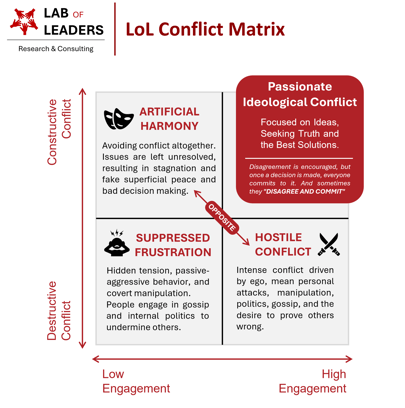LoL Conflict Matrix: Transforming Workplace Disputes into Growth Opportunities
In today’s fast-paced business world, conflict is inevitable. But not all conflict is created equal. The difference between a thriving organization and one stuck in stagnation often boils down to how conflict is handled. Enter the Lab of Leaders (LoL) Conflict Matrix, a groundbreaking tool designed to redefine workplace conflict, turning it from a productivity killer into a driver of innovation and success. This blog post will delve deep into the four conflict types identified in the LoL Conflict Matrix, explain why Passionate Ideological Conflict is the gold standard for high-performing teams, and provide actionable steps to foster this within your organization.
Abdullah MAQ
12/29/20243 min read


What Is the LoL Conflict Matrix?
The Lab of Leaders (LoL) Conflict Matrix categorizes conflict along two key dimensions:
Engagement Level (Low to High): How actively people participate in conflicts.
Conflict Type (Constructive to Destructive): Whether the conflict leads to resolution and growth or results in toxicity and setbacks.
The Matrix divides conflicts into four quadrants:
Artificial Harmony (Low Engagement, Constructive Conflict)
Suppressed Frustration (Low Engagement, Destructive Conflict)
Hostile Conflict (High Engagement, Destructive Conflict)
Passionate Ideological Conflict (High Engagement, Constructive Conflict)
Let’s break down each type and why they matter.
1. Artificial Harmony: The Illusion of Peace
Definition: This occurs when teams avoid conflict altogether. Issues are swept under the rug, creating a superficial sense of calm.
Why It’s Harmful:
Stifles creativity and innovation.
Leaves critical problems unresolved.
Leads to poor decision-making as key perspectives are excluded.
Example: A team nodding along in meetings but silently disagreeing, leading to passive resistance later.
Takeaway: Artificial Harmony may feel comfortable, but it’s a trap that stunts organizational growth.
2. Suppressed Frustration: The Silent Killer
Definition: Hidden tension festers beneath the surface, manifesting as passive-aggressive behavior, gossip, and covert manipulation.
Why It’s Harmful:
Creates a toxic work environment.
Reduces trust among team members.
Diverts energy away from productive tasks.
Example: Employees undermining each other’s work instead of addressing disagreements openly.
Takeaway: Suppressed Frustration drains morale and undermines collaboration.
3. Hostile Conflict: The Battlefield
Definition: This is when conflict escalates into personal attacks, ego-driven arguments, and attempts to prove others wrong.
Why It’s Harmful:
Damages relationships and team cohesion.
Distracts from organizational goals.
Erodes psychological safety, making team members reluctant to share ideas.
Example: Meetings devolving into shouting matches with no resolution in sight.
Takeaway: Hostile Conflict destroys trust and derails progress.
4. Passionate Ideological Conflict: The Gold Standard
Definition: Constructive, high-engagement conflict focused on ideas, seeking truth, and finding the best solutions.
Why It’s Powerful:
Encourages diverse perspectives and critical thinking.
Builds trust and mutual respect as teams challenge ideas, not individuals.
Drives innovation and better decision-making by rigorously testing assumptions.
Key Feature: Teams embrace the mantra of “Disagree and Commit” like Amazon and Intel—fostering open debate but rallying behind a decision once it’s made.
Example: A team passionately debating the best strategy but leaving the room aligned, committed and energized.
Takeaway: Passionate Ideological Conflict is the secret sauce of high-performing teams and resilient organizations.
Why Passionate Ideological Conflict Is Non-Negotiable
In an era of rapid change, organizations that encourage Passionate Ideological Conflict gain a competitive edge. Here’s why:
1. Innovation Requires Tension
Great ideas rarely emerge from comfort zones. When teams challenge each other’s assumptions and push boundaries, breakthroughs happen.
2. Trust Through Transparency
When conflict is about ideas and not personal agendas, it builds trust. Team members feel heard and valued, creating a culture of psychological safety.
3. Better Decision-Making
Rigorous debate ensures that decisions are well-informed and thoroughly vetted, reducing costly mistakes down the line.
4. Stronger Commitment
The “Disagree and Commit” principle ensures that everyone supports the final decision, even if they initially disagreed. This alignment boosts execution and results.
How to Foster Passionate Ideological Conflict
Cultivating this type of conflict requires deliberate effort. Here’s how:
1. Set the Right Tone
Leaders must model constructive conflict by inviting dissent and valuing diverse perspectives.
Emphasize that attacking ideas, not people, is the norm.
2. Create a Safe Space
Encourage psychological safety by rewarding candor and discouraging retaliation.
Provide training on constructive communication.
3. Define the Rules of Engagement
Establish clear ground rules for debates, such as staying respectful and focusing on facts.
Use tools like a neutral facilitator to guide discussions when needed.
4. Normalize “Disagree and Commit”
Reinforce the idea that once a decision is made, the entire team rallies behind it.
Highlight success stories where this principle led to outstanding results.
5. Recognize and Reward
Celebrate teams that engage in constructive conflict and deliver exceptional outcomes.
Provide feedback to individuals who exemplify this behavior.
Final Thoughts: Harnessing Conflict for Growth
Conflict doesn’t have to be a dirty word. The LoL Conflict Matrix shows us that with the right approach, it can be a catalyst for growth, innovation, and success. By striving for Passionate Ideological Conflict, organizations can unlock the full potential of their teams and create a culture of excellence.
Are you ready to transform conflict into a competitive advantage? Share your thoughts in the comments or reach out to learn how the Lab of Leaders can help your organization thrive.
LAB OF LEADERS
Finding What Works, Simplified For Leaders
Contact Us
+601125101301
© 2024. All rights reserved.
